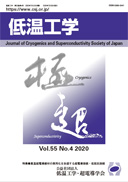
- Issue 6 Pages 379-
- Issue 5 Pages 313-
- Issue 4 Pages 247-
- Issue 3 Pages 147-
- Issue 2 Pages 87-
- Issue 1 Pages 1-
- |<
- <
- 1
- >
- >|
-
Shirabe AKITA2020Volume 55Issue 4 Pages 247
Published: July 20, 2020
Released on J-STAGE: August 03, 2020
JOURNAL FREE ACCESSDownload PDF (649K)
-
Hirofumi YAMASAKI, Satoshi AWAJI2020Volume 55Issue 4 Pages 254
Published: July 20, 2020
Released on J-STAGE: August 03, 2020
JOURNAL FREE ACCESSDownload PDF (529K)
-
MUKOYAMA Shinichi2020Volume 55Issue 4 Pages 255-261
Published: July 20, 2020
Released on J-STAGE: August 03, 2020
JOURNAL FREE ACCESSThe superconducting joint is utilized for superconducting magnets operated using persistent current mode. MRI, NMR, and MCZ, which are commercial products in the superconducting market, are also operated using persistent current mode, and are constructed with low-temperature superconducting wires. Since these magnets need a constant and stable magnet field for long period of time, the superconducting joints must have extremely low resistivity, lower than 10-11 Ω to avoid rapid degradation of the magnetic field. Commercial low-temperature superconducting wires have NbTi or Nb3Sn filaments embedded in stabilizing materials such as copper or aluminum matrixes. To realize a low-resistance joint, the stabilizing materials are removed and the mutual filaments are directly jointed. This manuscript introduces superconducting joint methods for low-temperature superconducting wires, which has been developed by the superconducting magnet manufactures and related R&D institutions.
View full abstractDownload PDF (887K)
-
- iGS Joints Realizing an HTS NMR Magnet Operated in a Persistent Current Mode -Kotaro OHKI, Tatsuoki NAGAISHI, Takeharu KATO, Yoshinori YANAGISAWA, M ...2020Volume 55Issue 4 Pages 262-267
Published: July 20, 2020
Released on J-STAGE: August 03, 2020
JOURNAL FREE ACCESSA superconducting joining method for high-temperature superconductors (HTSs) is one of the key technologies needed to realize persistent current operations in HTS magnets such as NMR and MRI. We have succeeded in developing a practical superconducting joining method between REBa2Cu3Oy (REBCO, RE: rare earth elements)-coated conductors with a microcrystalline REBCO precursor intermediate layer. The microcrystalline REBCO precursor intermediate layer is sandwiched between c-axis oriented REBCO layers and is joined with them. The crystal growth process during heat treatment has been investigated by observing cross-sectional views of the precursor layer. Cross-sectional TEM images showed that the precursor grew epitaxially from both the upper and lower surfaces of the c-axis-oriented REBCO layers. Then the entire precursor grew with both of the REBCO layers being joined with c-axis orientation. The iGS joint gives a critical current of >70 A at 77 K under self-magnetic fields. The total processing time, including joining heat treatment and oxygen annealing, is less than one day. This joining method allows us to operate a 400-MHz (9.4 T) HTS NMR magnet with a sufficiently stable magnetic field, and thus we have succeeded in obtaining NMR spectra.
View full abstractDownload PDF (1286K) -
Kohki TAKAHASHI, Satoshi AWAJI2020Volume 55Issue 4 Pages 268-274
Published: July 20, 2020
Released on J-STAGE: August 03, 2020
JOURNAL FREE ACCESSThe superconducting joint is a key technology to achieve persistent current operation for MRI and NMR magnets, thereby enabling to obtain higher resolution and sensitivity. A persistent current system including a superconducting joint, a persistent current switch and a double pancake coil fabricated with a REBCO tape was prepared by Furukawa Electric Co., Ltd. The magnetic-field decay behaviors during persistent current operation were observed in external fields of 0 and 1 T at 20 K. In a self-field, the decay rate of the persistent current excited up to 170 A reached 1.2 ppm/h after operating for five days, corresponding to a resistance of 5.1×10-13 Ω. From the current–voltage characteristics obtained from the magnetic field decay, it was found that the decay behavior of the persistent current is dominated by joint resistance in the case of high-load operation, but dominated by the shielding current in the case of low-load region of the operating current.
View full abstractDownload PDF (2454K)
-
Shuhei FUNAKI, Yugo MIYACHI, Yasuji YAMADA2020Volume 55Issue 4 Pages 275-279
Published: July 20, 2020
Released on J-STAGE: August 03, 2020
JOURNAL FREE ACCESSRecently, several novel techniques for creating superconducting joints between two REBCO-CCs have been suggested. These techniques include long-time oxidization annealing to compensate the oxygen deficiency of REBCO due to the high processing temperature. In this paper, a superconducting joint was achieved via a one-time heat treatment at the low temperature of 525ºC without oxidization annealing. The jointed GdBCO-CCs were prepared in three steps. The first step is that Eu–Ba–Cu–O raw material was placed between Ag-removed Gd123 layers of the CC. In the second step, the sample was mechanical pressurized using two plates of metal. Finally, the sample was heat-treated at 525ºC in KOH vapor. All steps were performed at ambient pressure. The jointed sample was bonded finely and showed Tconset = 76.7 K and Tczero = 57.5 K inclusive of the jointed region. From XRD observation of the jointed region in the samples, both GdBCO-CC and EuBCO-pressed materials contained incomplete RE123, RE247 and RE124 phases.
View full abstractDownload PDF (717K) -
Hiroshi TAKASHIMA, Kazuhiko TONOOKA, Yoshiyuki YOSHIDA, Mitsuho FURUSE2020Volume 55Issue 4 Pages 280-286
Published: July 20, 2020
Released on J-STAGE: August 03, 2020
JOURNAL FREE ACCESSIn order to prepare the jointing of high-temperature superconducting wires at relative room temperature, we developed elemental technologies. It was found that the superconducting jointing was difficult to realize in stacked YBCO/NbTi thin films. However, we succeeded in reducing the jointing resistance by inserting an Ag layer between the YBCO and NbTi thin films, and confirmed that the resistance was less than the PPMS measurement limit of 10-4 Ω.
View full abstractDownload PDF (1509K)
-
Masaru Masaru, Jun NAGAMATSU2020Volume 55Issue 4 Pages 287-288
Published: July 20, 2020
Released on J-STAGE: August 03, 2020
JOURNAL FREE ACCESSDownload PDF (1996K)
- |<
- <
- 1
- >
- >|